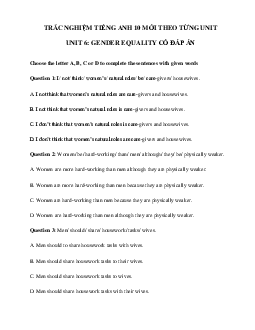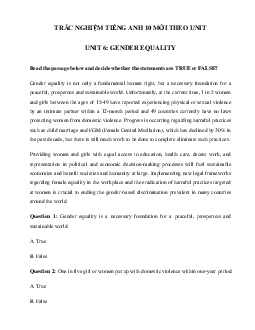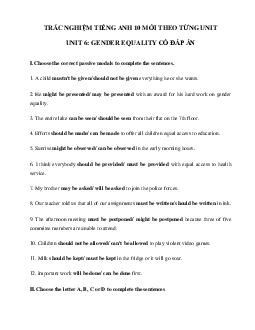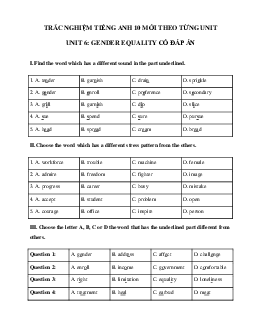










Preview text:
UNIT 6. GENDER EQUALITY A. PRONUNCIATION
Put the words in the correct columns according to the stressed syllable.
classical, develop, religious, understand, implement, continue, disappear, interview, misconduct,
justify, disinfect, hesitate, athletic, consistent, celebrate, entertain, reunite, absolute, accomplish,
classify, abandon, introduce, interrupt, curious, deliver, guarantee, isolate, recover, qualify, overflow, imagine, European
Stress on the first syllable
Stress on the second syllable Stress on the third syllable
II. Choose the word that has different stress pattern.
1. A. organize B. consider C. encourage D. fantastic
2. A. fantastic B. disagree C. dependent D. establish
3. A. criticise B. graduate C. favourite D. discover
4. A. overcome B. confident C. opposite D. violent
5. A. domestic B. expensive C. medical D. acknowledge B. VOCABULARY
I. Complete the sentences with the words in the box.
uneducated treat domestic violence forced equal
kindergarten surgeon gender firefighters low-paying
1. The vast majority believe it is essential for society to _________ women as equal to men.
2. Being _________ to quit your job due to pregnancy is a form of employment discrimination.
3. Many _________ teachers say their job makes the world a better place, but they don’t earn much.
4. Women considering the fire service may be discouraged if all the _________ they know or see are men.
5. Washing dishes is one of the few __________ jobs that is male dominated in the US, with
over 80 percent of dishwashers are men.
6. __________ equality implies that the interests, needs and priorities of both women and men
and girls and boys are taken into consideration.
7. Not only is a __________ one of the highest-paying healthcare jobs, but it’s also one of the highest-paying jobs overall.
8. The aim of gender equality in the workplace is to achieve broadly __________ opportunities
and outcomes for women and men.
9. __________ is the most common form of violence against women and its consequences affect
many areas of the lives of victims.
10. In many countries, there is a discrimination between educated and __________ , and men are
paid more for their work than women.
II. Choose the correct option to complete the sentences.
1. Women are now better educated and likely to pursue many (low-paying/ high- paying) jobs.
2. Men tend to be seen as independent, aggressive, and ambitious, whereas women are seen as
affectionate. (gentle/ violent), and compassionate.
3. There is still a discrimination against women employment that they can be forced to leave
their job when they get (single/ married).
4. Despite recent growth in (male/ female) participation rates, men still participate in labour
markets more frequently than women.
5. Gender (discrimination/ equality) describes the situation in which people are treated
differently simply because they are male or female.
6. Although women don’t have the same physical (weakness/ strength) as men do, it doesn’t
mean women provide less quality work.
7. Men are (physically/ mentally) stronger than women, who have, on average, less total muscle mass. Trang 1
8. The American Academy of Pediatrics supports funding for health care services for HIV-
infected (individuals/ organisations) and their families.
9. In India, more than 80% of (rural/ urban) women are engaged in agriculture, yet only about 15% own land.
10. Being (educated/ illiterate) by no means eliminates women from the workforce, but it does
drastically reduce their job opportunities.
III. Choose the best answer to complete the sentences.
1. It could cause depression if women are ________ to give up work to care for children.
A. treated B. forced C. hurt D. violated
2. ________ education occurs in schools, while informal education takes place primarily in the home.
A. Skilful B. Literate C. Professional D. Formal
3. Women’s ________ movement, also called women’s liberation movement, largely based in the United States.
A. duties B. authorities C. responsibilities D. rights
4. They say that they won’t stop until every woman and child is ________ from violence.
A. encouraged B. protected C. developed D. promoted
5. Numerous studies show how men and women are treated ________ at work, and how these differences affect behaviour.
A. commonly B. violently C. differently D. significantly
6. ________ First for Girls is a female youth volunteer group working to make the world a safe place for every girl.
A. Safety B. Independence C. Freedom D. Happiness
7. Women are not ________ the same job opportunities as men when it comes to executive positions.
A. paid B. earned C. given D. created
8. On June 16,1963, aboard Vostok 6, Soviet ________ Valentina Tereshkova became the first woman to travel into space.
A. Doctor B. Engineer C. Firefighter D. Cosmonaut
9. Housewives are the ones who don’t have a job outside the ________ and who spend their most
of time cleaning, cooking, looking after their family, etc.
A. school B. home C. workplace D. public areas
10. Are there businesses that ________ women and girls with safe spaces from street harassment?
A. provide B. increase C. benefit D. care
IV. Supply the correct form of the word in the brackets.
1. Many companies are working toward achieving __________ pay for all employees. (equality)
2. Year by year, more and more women have become highly __________ professionals. (educate)
3. __________ and career can negatively or positively impact a woman’s life when she combines them. (marry)
4. Mr. Law is __________ and professional and always answers our concerns thoroughly. (skill)
5. Parents work hard to help their children to develop into resilient, confident, responsible and __________ adults. (care)
6. __________ , many unpaid household work activities have been considered women’s work. (tradition)
7. A nurse is a __________ professional who helps physicians provide medical care to patients. (medicine)
8. Maternal __________ of parenting has a major influence on the way mothers interact with their children. (know) Trang 2
9. More women hold jobs as a secretary or administrative __________ than any other position in the United States. (assist)
10. There is immense __________ for women to reach a certain level of career and financial
success before becoming parents. (press) C. GRAMMAR
I. Supply the passive form of the verbs in the brackets.
1. There is a growing consensus that men __________ (must include) in gender equality work.
2. The concrete needs of women and non-Western people __________ (should give) importance.
3. Globally, the economic imbalance between men and women __________ (ought to address).
4. __________ women __________ (may empower) to become more aware of and engaged in political processes?
5. Any desirable consequences of having more women in top positions __________ (can achieve) through reforms.
6. Agender equality perspective __________ (might incorporate) when care programmes are developed.
7. An education system that is inequitable and discriminatory __________ (can’t consider) of high quality.
8. Humanity faced ambitious challenges that __________ (couldn’t tackle) without equal
participation of women in development.
9. The gender mainstreaming strategy __________ (can imply) through references to gender- sensitive programmes.
10. The global movement of women fighting the climate crisis __________ (couldn’t contain) by one country’s borders.
II. Supply the passive form of the modals in the brackets and the verbs in the box.
say refuse give consider misunderstand
achieve allow combine teach reflect
1. Both female and male students __________ (ought to) about gender equality at schools.
2. Pregnant women __________ (can’t) to have benefits, including health or life insurance.
3. Both men and women __________ (must) equal opportunities to participate voluntarily in all activities.
4. There was a belief that gender equality __________ (could) in a society like Sweden.
5. To this date, it __________ (can’t) that women’s human rights have been fully guaranteed.
6. If the project obtains 60% or more female roles, __________ it __________ (could) as a female-driven project?
7. Equity strategies to attain gender equality __________ (should) in policies and practices.
8. Women __________ (must) to control their bodies including how many children they want to have.
9. When a woman marries, it __________ (may) that she makes choice of the management of a household.
10. __________ feminism and environmentalism __________ (might) to promote respect for women and the natural world?
III. Choose the best answer to complete the sentences.
1. Women ________ as men, but people ________ how that is practiced.
A. ought to be respected and valued - should discuss
B. ought to respect and value - should be discussed
C. ought to be respected and valued - should be discussed
D. oughtn’t to respect and value - should discuss
2. Gender stereotypes are dangerous because they ________ situations that we ________ in our perceptions.
A. can’t cause - might disorient B. can be caused - might be disoriented
C. can be caused - might disorient D. can cause - might be disoriented Trang 3
3. Judges ________ in gender issues, and institutions dealing with cases of violence against
women ________ for compliance with the law.
A. should train - should monitor B. should be trained - should monitor
C. should be trained - should be monitored D. should train - should be monitored
4. Gender equality in sport _______ by women alone, and men _______ to bring about change.
A. can’t achieve - must be included B. can’t be achieved - must be included
C. can’t achieve - must include D. can be achieved - mustn’t include
5. Objectification ________ out, and girls ________ to tell their own stories - ones that reflect
their power, potential and diversity.
A. must be called - mustn’t be encouraged
B. mustn’t be called - mustn’t be encouraged
C. mustn’t be called - must be encouraged
D. must be called - must be encouraged
6. Gender equality and empowerment of women ________ an inextricable link and ________ together.
A. can have - ought to handle B. can be had - ought to be handled
C. can have - ought to be handled D. can be had - ought to handle
7. Women ________ to possess farmlands, and cultural norms that limits women from taking
part completely in agriculture ________.
A. ought to be permitted - ought to be abrogated
B. ought to permit - ought to abrogate
C. ought to be permitted - ought to abrogate
D. ought to permit - ought to be abrogated
8. Showing a degrading image of women in films ________ to encourage violence, whereas
showing positive images of men and women ________ to help counter it.
A. may be seen - may be seen B. might be seen - can see
C. must see - might see D. could see - should be seen
9. A gender stereotype is a preconception about characteristics that ________ or the roles that ________ by women and men.
A. ought to possess - should perform
B. ought to be possessed - should perform
C. ought to be possessed - should be performed
D. ought to possess - should be performed
10. We ________ that without improving the status of women, little ________ in the effort to
solve problems at a global scale.
A. must be recognized - could be achieved B. must recognize - could be achieved
C. must be recognized - could achieve D. mustn’t recognize - couldn’t achieve
IV. Complete the second sentences in the passive voice.
1. They must include women in the human rights protection system. Women must
2. Can you identify and address gender equality perspectives and strategies? Can ?
3. People should maintain the principles of impartiality and non-selectivlty. The principles
4. We can empower women to identify and address challenges and constraints. Women can
5. They may require a range of targeted interventions to achieve gender equality.
A range of targeted interventions may
6. Should they consider women a sector when it comes to development funding? Should ?
7. We couldn’t see gender injustice just as being perpetrated by outside forces. Trang 4 Gender injustice
8. They must turn around the underinvestment in women’s economic empowerment. The underinvestment in
9. Social participation in community through volunteering could promote active aging. Active aging
10. Can the activists utilize gender mainstreaming mandates systematically and effectively? Can ?
11. The high cost of living might force girls to drop out when they start school. When girls start school, they
12. They must mainstream gender equality into all sustainable development goals as a cross- cutting issue. Gender equality must
13. What can we do to overcome gender bias and create a world with equal opportunities? What can ?
14. Organisations shouldn’t underestimate the impact of gender-equality on socioeconomic trends. The impact of
15. The governments could support human rights projects, in full respect of the sovereignty of all countries. Human rights projects
16. The authorities should encourage committees and councils to record cases of violence against women.
Committees and councils should
17. Should they give top priority to realize gender equality, regardless of the socioeconomic conditions? Should ?
18. Schools must protect both male and female students from psychological, physical, and sexual abuse. Both male and female students
19. When the labour market becomes unstable, industrial restructuring might affect women.
When the labour market becomes unstable, women
20. Teachers ought to admonish female students to approach science subjects, especially mathematics. Female students
V. Choose the underlined part that needs correcting.
1. They could give more consideration to pursuing gender equality relating actions in A B C D several areas.
2. Workers in different fields, like agriculture and health, might be trained to integrate A B C gender in what they are done. D
3. All students ought to exposed to the same curricula although the coursework may be A B C D taught differently.
4. The discrepancy between the value attached to women’s work in relation to men’s A B C work should resolve. D
5. We must give girls and women priority in the field of education because persistent A B C Trang 5
gender inequality in this sphere. D
6. Could be gender mainstreaming tools and mechanisms be formalised in government A B C D institutions and processes?
7. Liberal feminists write about ways in which women’s voice can give equal importance A B C to men’s voice. D
8. The more women there were in governments, the most it would be accepted that they A B C belonged to where they were. D
9. The decision-making processes of women may be resisted if she haven’t been involved A B C D in community affairs.
10. People could discuss gender injustice in a vacuum - it had to be looked at in the A B C
context of all those who were discriminated against. D D. SPEAKING
I. Choose the best answer to complete the dialogues.
1. - “Could I check out before you, Sir?” - “Sure. ________”
A. The first lady. B. Ladies first.
C. Gentlemen first. D. The last gentleman.
2. - “Did you learn any first aid at school?” - “________”
A. You’re right. It’s useful to learn first aid.
B. No, they didn’t teach first aid at school but at the hospital.
C. Yes, when I was in grade 9.
D. No, the teachers only taught us first aid.
3. - “________ “It’s a remedy for discrimination.”
A. How do you think about the Gender Equality Policy?
B. What is the Gender Equality Policy about?
C. Do you find the Gender Equality Policy effective?
D. Will they bring in a policy for gender discrimination?
4. - “Does he know I’m here?” - “________”
A. Yes, he knows you. B. No, he’s not here.
C. No, I don’t know. D. Yes, he does.
5. - “________” - “They recruit both women and men for that position.”
A. Are they still looking for candidates for the position of Executive Assistant?
B. I don’t know if the Executive Assistant position is open for males.
C. What do they require for the Executive Assistant position?
D. Some people think the assistant role is female dominated.
II. Match the sentences.
1. I see most nurses are women. a. Yes, both of them.
2. What are the requirements for this position? b. Evidently not.
3. Can both men and women do this job?
c. You’re right, but there are more and more
4. I’d like you to explain your childish men working as a nurse. behaviour. d. Yes, absolutely.
5. I’m working part-time as a shop assistant.
e. I’m afraid I disagree. There are more boys
6. Shall we meet at the central post office on than girls in my science class. Trang 6 Sunday morning?
f. You must have a Bachelor’s degree in
7. Science is equally taught to boys and girls.
engineering plus two years of working
8. Do you confide in his honesty? experience.
9. Women are no longer dominated by men in g. That’s not true. Women’s self-worth is still their relationships. threatened in marriages.
10. I’m afraid I couldn’t finish the work last h. Really? How much do you earn a month? night.
i. I couldn’t agree more on the date, but we should find another venue.
j. I’m sorry, but I didn’t intentionally let you down. E. READING
I. Read the passage and choose the best answers to fill in the blanks.
(1) __________ in girls’ education transforms communities, countries and the entire world.
Girls who receive an education are less likely to marry young and more likely to (2) __________
healthy, productive lives. They earn higher (3) __________ , participate in the decisions that
most affect them, and build better futures for (4) __________ and their families.
Girls’ education strengthens economies and reduces (5) __________ . It contributes to more
stable, resilient societies that give all individuals - including boys and men - the opportunity to fulfil their (6)__________ .
But education for girls is about (7) __________ than access to school. It’s also about girls
feeling (8) __________ in classrooms and supported in the subjects and careers they choose to
pursue - including those in which they are often under-represented.
1. A. Paying B. Investing C. Exploiting D. Making
2. A. live B. have C. spend D. lead
3. A. incomes B. profits C. money D. career
4. A. themselves B. ourselves C. herself D. himself
5. A. quality B. equally C. equality D. inequality
6. A. potent B. potential C. potency D. impotence
7. A. rather B. better C. more D. less
8. A. uneasy B. tired C. safe D. worried
II. Read the passage and choose the best answers to the questions.
Gender defines and differentiates what women and men, and girls and boys, are expected to
be and do (their roles, responsibilities, rights and obligations).
While there are very distinct biological differences between boys and girls and these can
create different needs and capacities for each, these differences do not in themselves lead to or
justify unequal social status or rights. The distinct roles and behaviours that are defined for boys
and girls, and men and women in a society may give rise to gender inequalities, i.e. differences
between men and women that systematically favour one group.
Gender can be a key determinant of who does what, who has what, who decides, who has
power, and even who gets an education or not. In many societies, boys are seen as the ones who
should be educated, while girls are not.
UNICEF states that Gender equality means that women and men, and girls and boys, enjoy
the same rights, resources, opportunities and protections. Gender inequality arises when one
group is seen in a society as having more rights than the other. International declarations such as
CEDAW promote and defend women’s rights, and therefore, today, gender equality is promoted
as a fundamental condition for the full enjoyment of human rights by women and men. This
right is recognized as a condition for growth and development and global organizations promote
gender equality in their work.
Nevertheless, gender inequalities persist in a wide range of areas. Overcoming gender
inequalities requires profound transformations in social structures and relationships between men and women. Trang 7
1. Which of the following best serves the title of the passage? A. What is gender inequality?
B. Roles, responsibilities, rights and obligations of women and men
C. Social status and rights of women and men
D. Gender equality on a global scale
2. According to the first and the second paragraphs, what may give rise to gender inequalities?
A. Distinct biological differences between men and women
B. Different needs and capacities between men and women
C. Distinct roles and behaviours of men and women in a society
D. Men and women’s roles, responsibilities, rights and obligations
3. The passage suggests that ________ are prone to gender inequalities. A. only women B. only men
C. both women and men D. either women or men
4. The phrase ‘This right’ in the fourth paragraph refers to ________.
A. any of the human rights B. gender equality
C. women’s rights D. human rights
5. Which of the following is true according to the passage?
A. Gender can be a key determinant of who gets an education or not.
B. Gender equality means that women should enjoy more rights, resources, opportunities and protections than men do.
C. UNICEF only promotes and defends women’s rights when gender inequality arises.
D. Overcoming gender inequalities requires women to replace their social structures and
relationships with those of men. E. WRITING
I. Choose the sentence which has the closest meaning to the original one.
1. FIFA Women’s World Cup is held every four years.
A. They held FIFA Women’s World Cup in four years.
B. There is a FIFA Women’s World Cup every four years.
C. FIFA has held the Women’s World Cup for four years.
D. It takes four years for them to hold a FIFA Women’s World Cup.
2. Is the surgeon’s job traditionally done by men?
A. Is it the tradition that the surgeon’s job is done by men?
B. Do men have a tradition of doing the surgeon’s job?
C. Is it traditional for men to do the surgeon’s job?
D. Do men break the tradition by doing the surgeon’s job?
3. Some women are unable to read or write.
A. Most women can read or write.
B. The fact that some women are unable to read or write is impossible.
C. It’s possible for some women to read or write.
D. Some women can’t read or write.
4. More than half of the world’s uneducated people are women.
A. Women are more educated than men in the world.
B. Men are more uneducated than women in the world.
C. There are more educated men than educated women in the world.
D. There are fewer uneducated women than uneducated men in the world.
5. Men often earn more than women for doing the same job.
A. Men outnumber women in both earning and doing the same job.
B. Women don’t often earn as much as men do for doing the same job.
C. To earn more than women, men often have to do the same job.
D. Doing the same job makes men earn more than women.
II. Complete the second sentence so that it has a similar meaning to the first one. Trang 8
1. Cooking classes may not be offered to only female students. They may not
2. We must prevent violence against women and girls. It’s essential
3. It’s necessary to encourage women to pursue a career in the sciences. Women need to
4. It’s not great to have only boys or girls in a class. Having only
5. They may not allow girls to be pilots in some countries. Girls may not
6. At what age did most of the girls in your village get married? How old ?
7. Women have to work longer than men to earn the same amount of money. Men don’t
8. Although women have to do more work, the rate of poverty among women is still high. Women have to
9. If girls receive more education, they are likely to have better jobs and higher salaries. The more education
10. Child marriage might carry health risks as young girls aren’t physically developed to give birth. Young girls aren’t KEY
UNIT 6: GENDER EQUALITY A. PRONUNCIATION I.
Stress on the first syllable
Stress on the second syllable Stress on the third syllable
classical, implement, interview, develop, religious, continue, understand, disappear, justify, hesitate,
celebrate, misconduct, athletic, consistent, disinfect, entertain, reunite, absolute, classify,
curious, accomplish, abandon, deliver, introduce, interrupt, isolate, qualify recover, imagine guarantee, overflow, European
II. l. A 2. B 3. D 4. A 5. C B. VOCABULARY
I. 1. treat 2. forced 3. kindergarten 4. firefighters 5. low-paying
6. Gender 7. surgeon 8. equal 9. Domestic violence 10. uneducated
II. 1. high paying 2. gentle 3. married 4. female 5. discrimination
6. strength 7. physically 8. individuals 9. rural 10. illiterate
III. l. B 2. D 3. D 4. B 5. C 6. A 7. C 8. D 9. B 10. A
IV. 1. equal 2. educated 3. Marriage 4. skilful 5. caring
6. Traditionally 7. medical 8. knowledge 9. assistant 10. pressure C. GRAMMAR
I. 1. must be included 2. should be given 3. ought to be addressed
4. May . . . be empowered 5. can be achieved 6. might be incorporated
7. can’t be considered 8. couldn’t be tackled 9. can be implied 10. couldn’t be contained
II. 1. ought to be taught 2. can’t be refused 3. must be given Trang 9
4. could be achieved 5. can’t be said 6. could . . . be considered
7. should be reflected 8. must be allowed 9. may be misunderstood 10. Might. . . be combined
III. l. A 2. D 3. C 4. B 5. D 6. C 7. A 8. A 9. C 10. B
IV. 1. Women must be included in the human rights protection system.
2. Can gender equality perspectives and strategies be identified and addressed?
3. The principles of impartiality and non-selectivity should be maintained.
4. Women can be empowered to identify and address challenges and constraints.
5. A range of targeted interventions may be required to achieve gender equality.
6. Should women be considered a sector when it comes to development funding?
7. Gender injustice couldn’t be seen just as being perpetrated by outside forces.
8. The underinvestment in women’s economic empowerment must be turned around.
9. Active aging could be promoted by social participation in community through volunteering.
10. Can gender mainstreaming mandates be systematically and effectively utilized by the activists?
11. When girls start school, they might be forced to drop out by the high cost of living.
12. Gender equality must be mainstreamed into all sustainable development goals as a crosscutting issue.
13. What can be done to overcome gender bias and create a world with equal opportunities?
14. The impact of gender-equality on socioeconomic trends shouldn’t be underestimated by organisations.
15. Human rights projects could be supported by the governments, in full respect of the sovereignty of all countries.
16. Committees and councils should be encouraged to record cases of violence against women by the authorities.
17. Should top priority be given to realize gender equality, regardless of the socioeconomic conditions?
18. Both male and female students must be protected from psychological, physical, and sexual abuse by schools.
19. When the labour market becomes unstable, women might be affected by industrial restructuring.
20. Female students ought to be admonished to approach science subjects, especially mathematics by teachers.
V. 1. C (related) 2. D (do) 3. B (be exposed) 4. D (be resolved)
5. C (because of/for) 6. A (Could) 7. B (can be given) 8. B (the more)
9. C (they) 10. A (couldn’t) D. SPEAKING
I. l. B 2. C 3. A 4. D 5. B
II. l. c 2. f 3. a 4. j 5. h 6. i 7. e 8. d 9. g 10. b E. READING
I. l. B 2. D 3. A 4. A 5. D 6. B 7. C 8. C
II. l. A 2. C 3. D 4. B 5. A F. WRITING
I. l. B 2. A 3. D 4. C 5. B
II. 1. They may not offer cooking classes to only female students.
2. It’s essential to prevent violence against women and girls.
3. Women need to be encouraged to pursue a career in the sciences.
4. Having only boys or girls in a class is not great. Trang 10
5. Girls may not be allowed to be pilots in some countries.
6. How old were most of the girls in your village when they got married?
7. Men don’t have to work as long as women to earn the same amount of money.
8. Women have to do more work, but the rate of poverty among women is still high.
9. The more education girls receive, the better jobs and higher salaries they are likely to have.
10. Young girls aren’t physically developed to give birth, so child marriage might carry health risks. Trang 11




